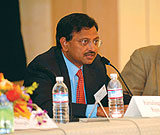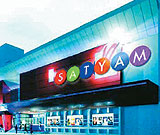|
INDIA
BUZZ
|
|
India plans to launch reusable spacecraft |
China crackdown to affect Indian medicos |

|

|
India is planning to launch a technology demonstrator of a reusable launch vehicle (RLV) in 2009, according to B.N. Suresh, director, Vikram Sarabhai Space Centre, Thiruvananthapuram.
The RLV is forerunner of the Indian version of the space shuttle. The unmanned vehicle will blast off like a rocket, come back like an aircraft and drop into the sea and can then be recovered.
It will be launched from the Indian Space Research Organisation’s spaceport at Sriharikota. “The technology demonstrator is a precursor to mastering technologies related to the reusable launch vehicles. It will vertically take off, go into the right atmosphere, then fly out of the dense atmosphere … It is basically for testing the hypersonic aerodynamics, the thermal protection system and a host of other technologies,” he said.
“Work is progressing on the technology demonstrator and we are planning to have the first launch in 2009,” Suresh said.
|
China’s crackdown on unqualified domestic medical colleges offering undergraduate courses in English language to foreign students has hit Indian students.
It is estimated that up to 10,000 Indian students, lured by cheap tuition fees (compared to that in India), may have enrolled in Chinese medical institutions since 2003.
Under China’s recent revamp of its medical education sector, it has allowed just 30 top-grade medical institutions across China to admit foreign students from the next academic year.
The ministry says the new provisions have been formulated for the purpose of standardising the management of undergraduate medical education in English for international students in China, ensuring quality teaching and promoting the sound development of education for international students.
|
|
|
|
Young Indians world’s happiest
|
Satyam to employ 2,000 people in Malaysia
|
|

|

|
Young people in India have shown up happiest—satisfied with their own personal lives and the situation in the country—in a 17-nation web survey.
The levels of satisfaction and optimism about the future of society were higher among young people in India than in Europe, US or China, according to the Global Youth Survey 2007 conducted by Sweden’s Kairos Future.
“Indians appear to be the happiest in this survey, coming out strongly on personal satisfaction,” according to Kairos Future, a research and strategy organisation that investigates trends. The survey analysed responses from 22,000 young people, most between 16 and 29 years, across 17 countries.
Seven out of 10 young Indians were happy with the situation in the country against three out of 10 Americans and Europeans.
|
IT giant Satyam has chosen Malaysia as its largest software development hub outside India with a capacity to employ 2000 people in two years. The company’s 100-seat Malaysian Global Solutions Centre will expand to over 500 seats in the next few months, according to Satyam Chairman Ramalinga Raju.
The centre is the first phase of the rollout of the company’s 2000-seat Global Delivery Campus in Malaysia’s IT park called Cyberjaya. The Campus, which is scheduled to be operational by 2009 will offer 2000 jobs for Malaysian graduates, Raju said in Kuala Lumpur at the launch of the Campus.
Raju said the company’s investment in Malaysia is reflected in the human capital.
Satyam will spearhead the development of some critical systems and directly support the software needs of some of its Fortune 500 clients. “In the last five to six years, we have grown significantly in Europe and Asia, including Middle East and Africa,” Raju said.
|
|
|
|
Movie tickets likely to cost less
|
India expects 8.5-9.0 pct GDP growth in 07/08
|
|

|

|
Movie-buffs can now hope to pay less for tickets if the Information and Broadcasting Ministry succeeds in persuading states to reduce entertainment tax on films.
Depending on the location of a theatre in the states, moviegoers pay anywhere between 40 and 100 per cent tax on a ticket—making India the “highest entertainment taxed” country in the world.
This is in contrast with other industries where excise duty is capped at 16 per cent and service tax at 15 per cent.
The film industry also coughs up 12.5 sales tax or value added tax on food and drinks, 12.36 service tax on the ad revenues, 12.5 VAT on distributor payouts and 12.36 service tax on property rentals.
In addition, there are minor taxes such as show tax, property tax, advertising tax, etc.
And if there is any profit left after all this, a 35 per cent income tax on that.
|
India’s economy is likely to grow by between 8.5-9 per cent in the financial year ending March 2008, and while there would be some moderation in growth from a year earlier there would be no slowdown, a top government official said Montek Singh Ahluwalia, deputy chairman of the Planning Commission.
“We have been predicting slightly lower growth in this year. The latest industrial output numbers are no reason to reassess growth estimates,” he said.
India, Asia’s third-largest economy, grew 9.4 per cent in the 2006/07 financial year. Industrial output in July rose 7.1 per cent from a year earlier, well below forecasts as the impact of tight monetary policy kicked in.
|
|
|
|
Civilian trekkers on course to Siachen
|
India most acquisitive of emerging economies
|
|

|

|
The Indian Army will open up the Siachen glacier to civilian tourists, despite Pakistan’s protests.
A trekking expedition comprising a team of 20, including civilians and cadets from the National Cadet Corps, under the guidance of the Indian Army will walk to the Siachen glacier after they adjust to the high altitude.
Pakistan protested the glacier is a disputed region and any action from the Indian Army will affect the ceasefire in the region and also the peace process.
India made it clear it ddidn’t need Pakistan’s permission as the region is a part of India and also under its control since 1984.
This is not the first time such an expedition is being undertaken. A month earlier an Indo-French expedition to Mamostong Kangri Peak, 30 km east of the Siachen glacier, took place.
“The message really is this is not disputed territory, that Siachen is part of India, or territory under Indian control in Jammu and Kashmir, and this sort of activity merely, in a sense, symbolises that fact,” said Bharat Karnad, a defense analyst with New Delhi’s Center for Policy Research. “Pakistan thinks such treks, in effect, undercut their claims.”
|
India has emerged as the most acquisitive of emerging nations as the global spread of Indian enterprise in recent years led to the takeover of several major western and other companies.
Experts believe that the spate of mergers and acquisitions by Indian companies can be likened to the ‘hunted fast becoming hunters’ in the corporate boardrooms of global capital.
Of the four major emerging economies—Brazil, Russia, India and China (BRIC)—India recorded the largest number of mergers and acquisitions activity during the first half of 2007, according to KPMG.
Deal flow between emerging and developed economies is beginning to converge as companies from the BRIC nations start to ramp up their M&A activity. The research, which analysed deal flows between nine selected emerging economies and 11 developed markets, shows companies from countries such as the BRIC nations are fast closing the gap on their counterparts in developed nations in terms of cross-border acquisitions.
|
|
|
|
|
|
|